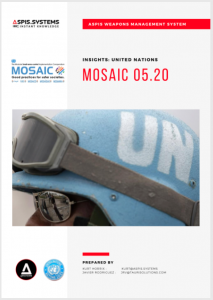Automated Inventory Management
ASPIS.Weapons Management System, delivers on the promise of a fully operational and automated armoury, deployed at the customer’s premise, compliant with International Standards such as defined by the United Nations.
UN Standards
Poor Weapons Storage will not result in a catastrophic event such as an explosion if ammunition is not present. It may, however, increase the risk that weapons are stolen and used illegally. ASPIS.Weapons Management System has been built to be 100% compliant with MOSAIC 05.20 Standards.

Following a 360° Assessment and Gap Analysis with regards to compliancy, security and automation, we deploy a Three-staged Risk Management model to obtain control of any inventory and are able to track your assets beyond the areas of confinement using ASPIS.InMotion.
RISK Management
To reduce the risks associated with Small Arms Light Weapons (SALW) storage to a level as low as reasonably possible, those responsible for SALW stockpiles can:
- 1. Improve the physical infrastructure of weapon storage.
- 2. Develop security plans and procedures, and ensure that personnel are trained to implement these plans and procedures
- 3. Track any movement of stock with automated inventory management and apply strict confinement zones
Physical Security
Weapons may be lost due to theft. Therefore, at Level One, there must be some form of physical security of weapons stocks. The aim of physical security is to reduce the probability of an incident occurring, and the severity of the incident.
The physical security of weapons should be achieved by the use of an armoury, a secure room,or, for small locations, a secure cabinet, built and secured up to standards.
Perimeter Security
Physical security systems should be derived from an effective risk assessment. An effective perimeter security infrastructure must be in place where access shall be controlled at all times, and restricted to authorised personnel only. Strict access control should be applied to Level Two measures in SALW storage areas.
Some of the measures involve control over keys and combination locks (see also secure locks and armed doors). In addition, only authorized personnel should be allowed access to the weapons storage area.
360° Assessment Result
Tags Deployed for Weapons and Gear
Average of 5 Tags per ID, including weapons, accessories and dog-tags
IDs Attached for Military Personnel
Total number of ID (personnel) managed by one ASPIS.SYSTEM
Standard Reports generated Every day
Purpose-built Reports are delivered when deploying the System
Budget cut-down per year
Total Spent cut-down per year, thanks to loss prevention and optimized use of weapons already available and managed by the System
ASPIS.Weapons Management System (ASPIS.WMS)
In addition to the physical security and location of SALW stockpiles, automated inventory management is a fundamental component of stockpile management.
The full application of Level Three measures will ensure that a safe,secure, effective and efficient conventional weapons management system is in place, and is in line with international “best practice.” using ASPIS proprietary secure RFID protocols.
Mobility and Weapons Transfer (*ASPIS.InMotion)
In some circumstances, especially where units are mobile, it may also be appropriate for small unit storage to use forms of mobile storage built into ISO containers or their equivalent.
Moving beyond the perimeter of the first and second confinement zone, the armories and the secured outdoor areas (see stages Level One and Two here above), the transfer of arms is limited to predefined confinement zones in the weapons system.
GAP Analysis
It may not be possible to immediately obtain full Level Three status, and it may be more appropriate to first aim for comprehensive attainment of Level One across the board, before then adopting some Level Two measures. This incremental approach is also preferable to having one ‘showcase’ location at Level Three, with other locations then being unable to meet even Level One standards. We deliver full 360° Gap Analysis through our network of qualified partners, allowing you to bring every of your armories up to standards, dispatching arms and gears more efficiently by effective use and distribution of your current inventories.
(*) ASPIS.InMotion is a component under development and only available to registered ASPIS.SYSTEMS clients with a fully functional operating environment. The roll-out of ASPIS.InMotion asks for detailed functional specifications being communicated by the client and is purpose-built for every specific customer.
 Weapons Tracking
Weapons Tracking 